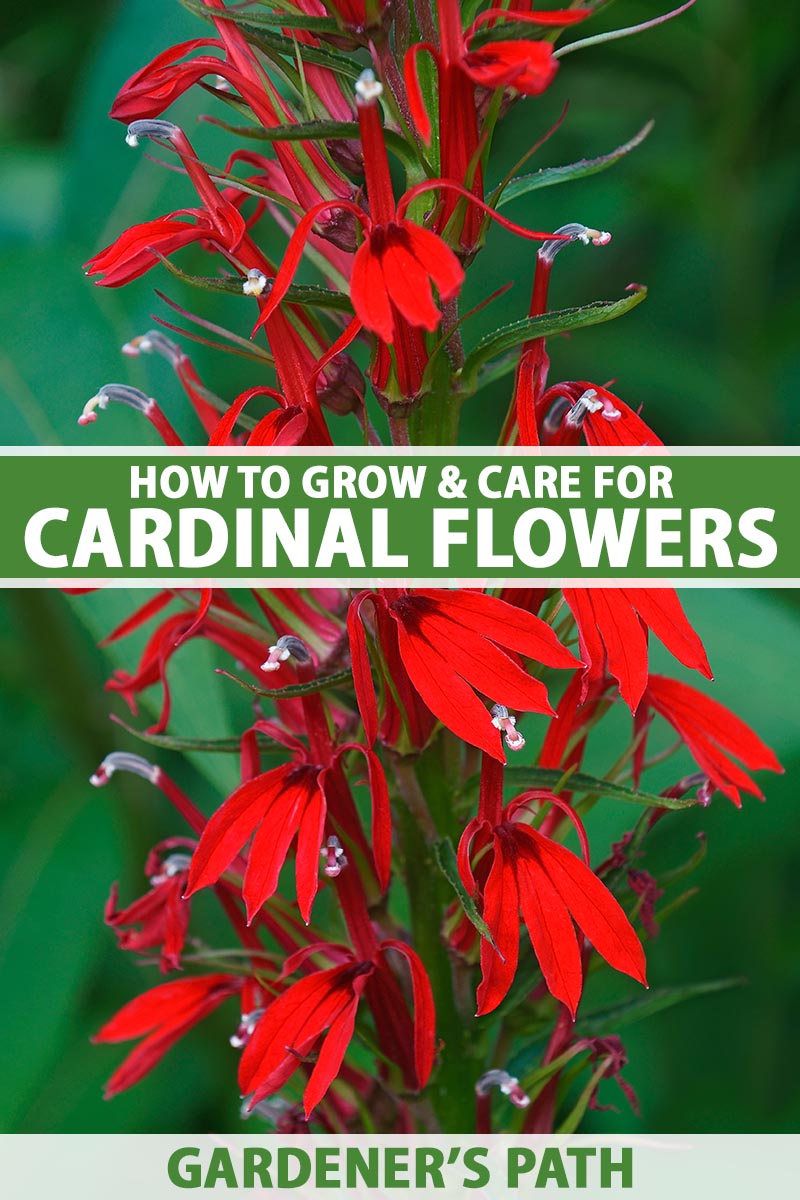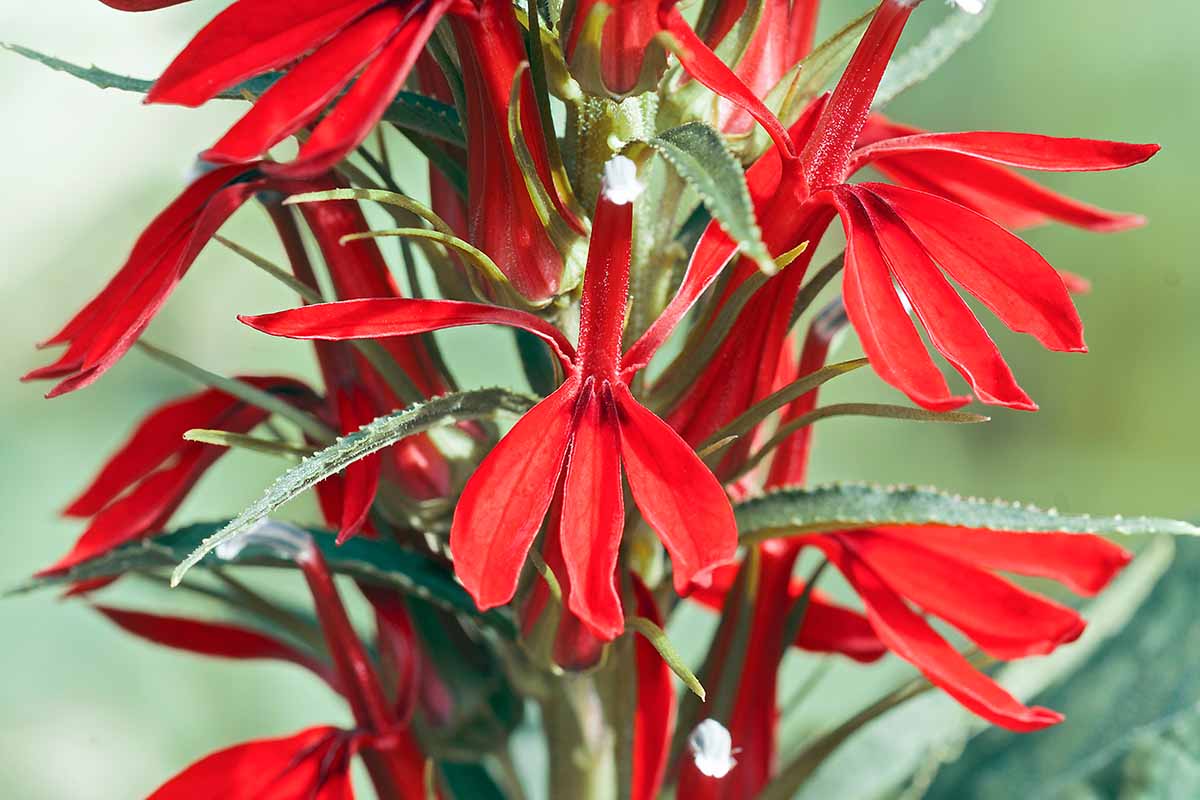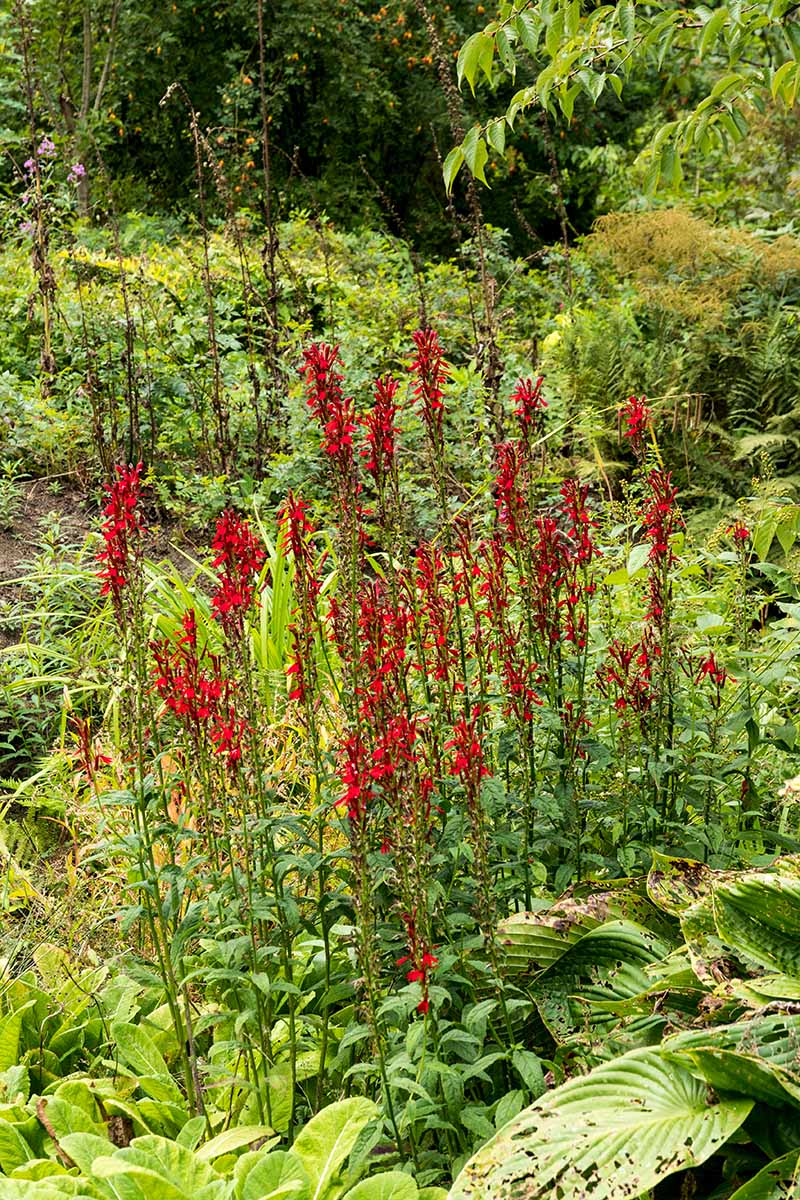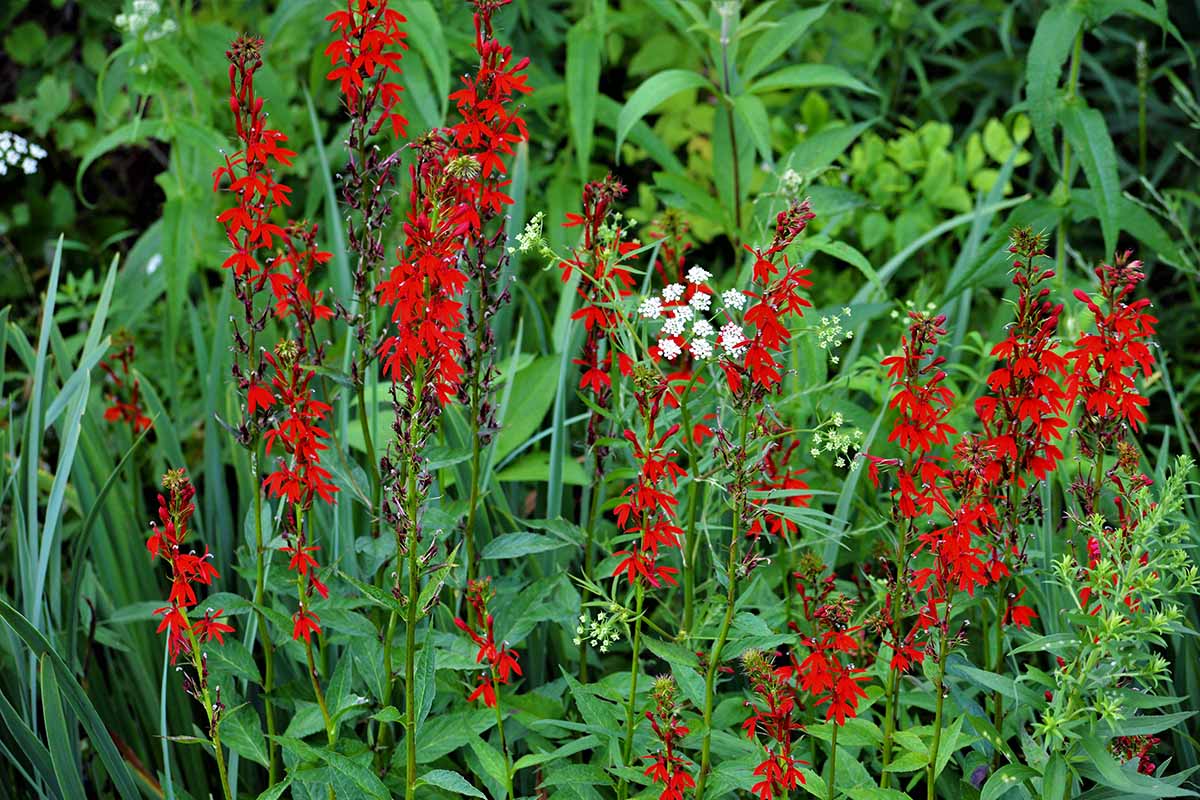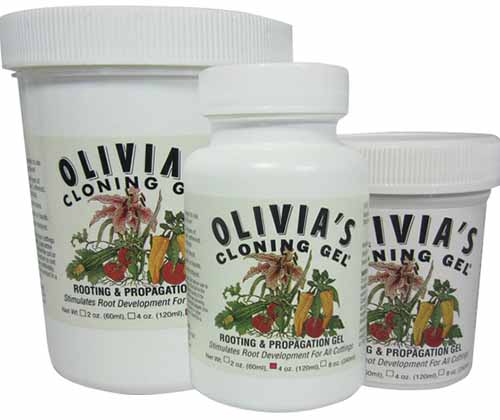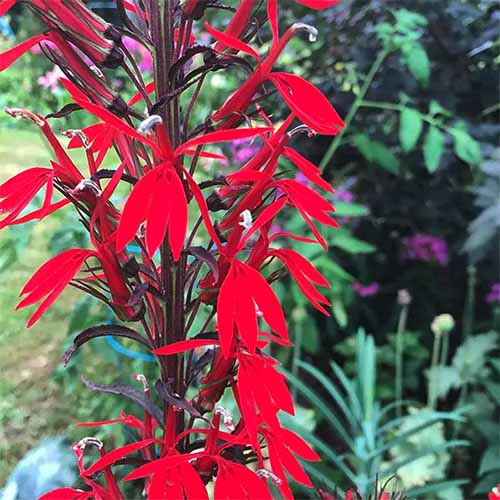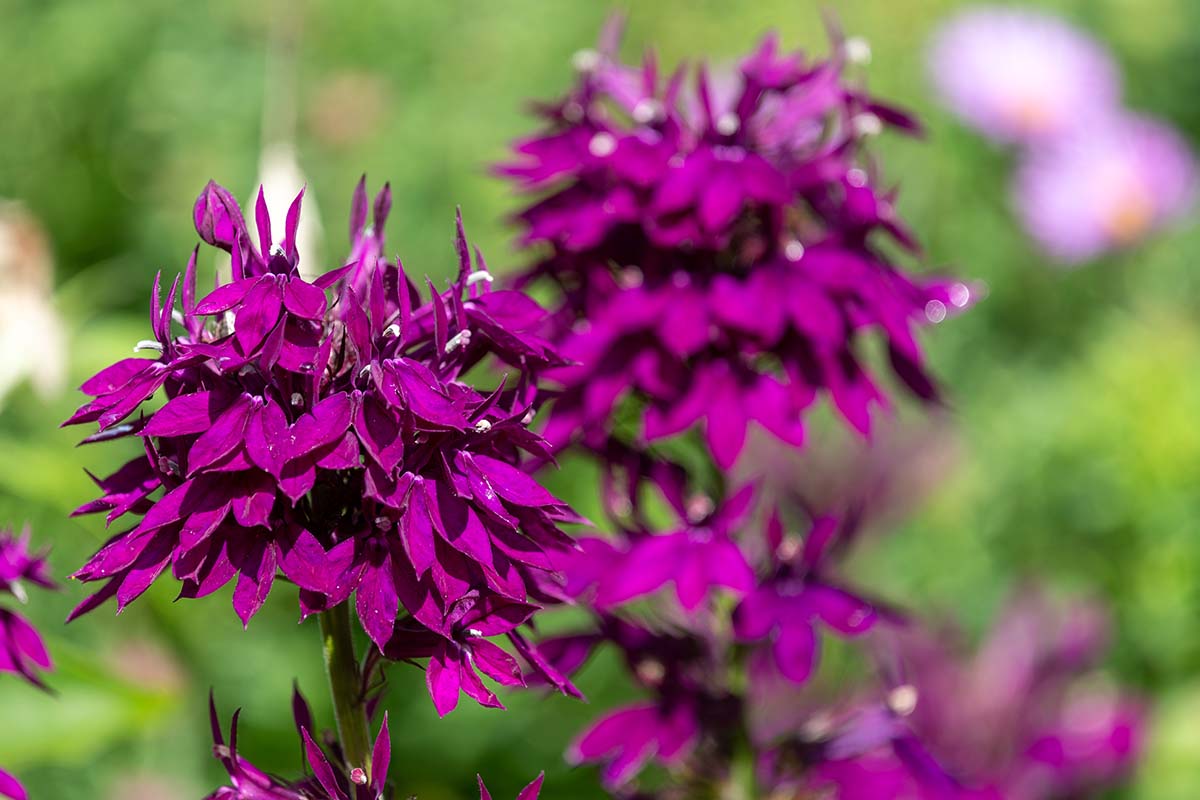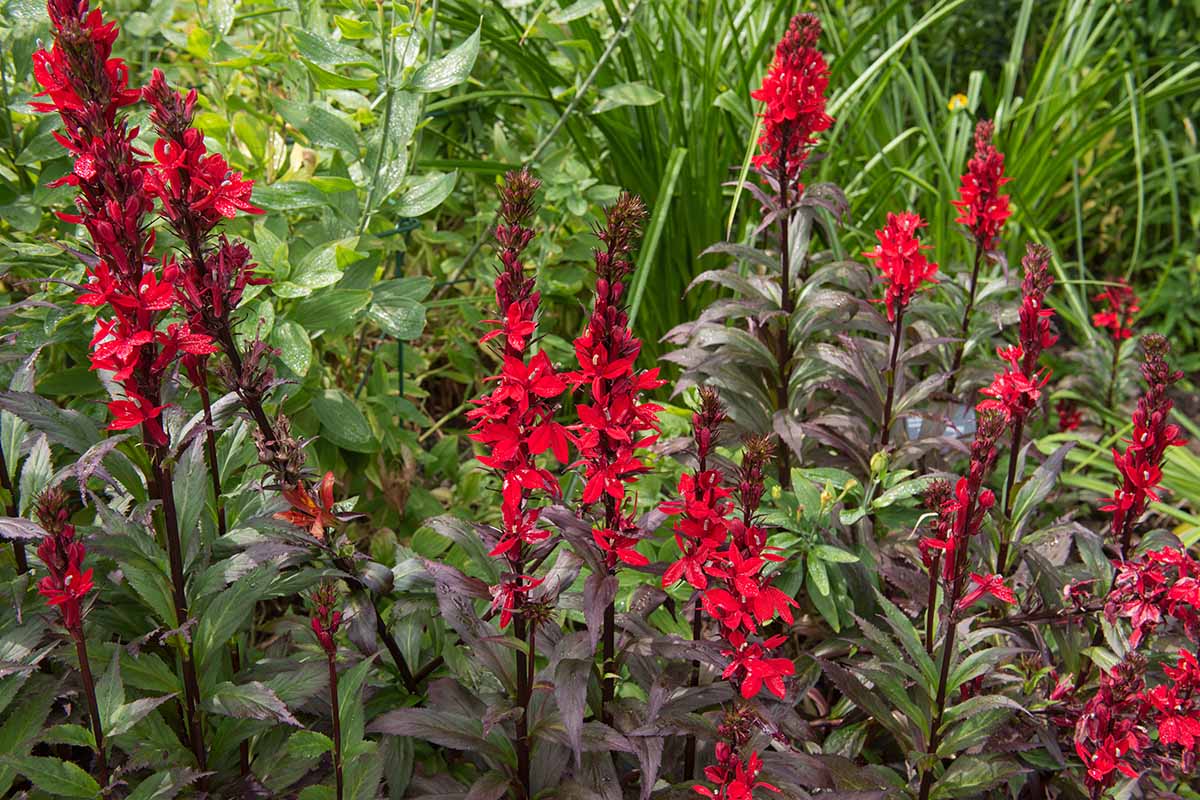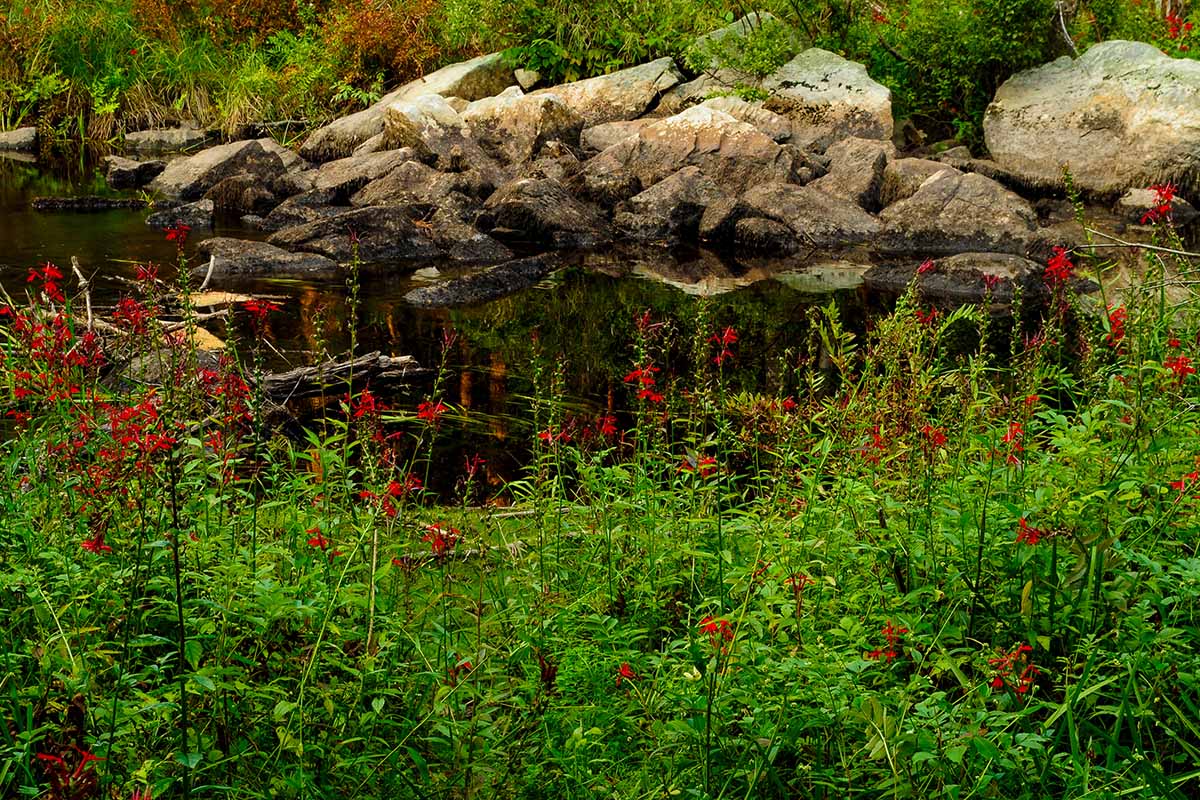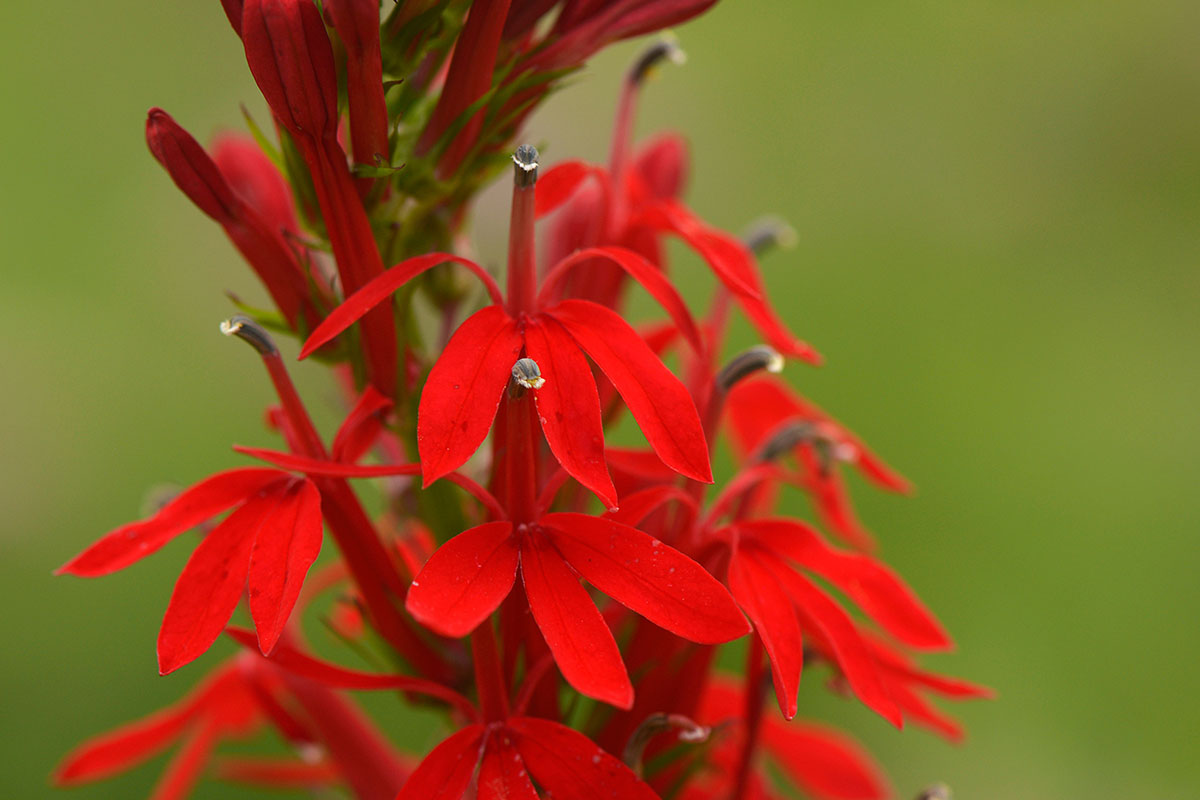Not only will the beautiful flowers catch your eye, they’ll attract and feed local populations of hummingbirds and butterflies as well. We link to vendors to help you find relevant products. If you buy from one of our links, we may earn a commission. We’re going to discuss everything you need to know to grow and care for this scarlet wildflower. Here’s what we’ll cover:
What Is Cardinal Flower?
Cardinal flower is a short-lived herbaceous perennial known for its striking spires of red blooms, held on upright plants that reach four to six feet tall. Its showy flower spikes can account for up to two feet of the plant’s height, and these are covered with bright red, velvety florets. Look closely and you’ll see that each floret has five petals – three on the bottom, and two on top. The bottom petals form a three-lobed lip. All five petals come together at their base, fused into a tube. Though showy, these one- to three-inch flowers are not known for being fragrant, attracting pollinators with their color rather than their scent. Florets open first at the bottom of the spike and work their way up, and the floral show lasts for four to six weeks. After flowering, fruits containing tiny seeds will form. The flower spikes also sport leaves, though the bulk of the plant’s foliage is found close to the ground in the form of a basal rosette, which remains evergreen during winter. Alternate leaves grow up to eight inches long, and they are lance-shaped and pointed at both ends, with serrated margins. These wildflowers grow from a taproot and they are clump-forming, with stems that are usually unbranched. As short-lived perennials, specimens typically live for two to four years but self-sow readily.
Cultivation and History
L. cardinalis has an extremely widespread native range, stretching from eastern Canada, throughout the eastern and central US, southwest to California, and continuing south through Central America and all the way to Colombia. Its natural habitats are usually wetlands – moist and wet areas such as bogs, swamps, and the sides of streams and creeks – but it also appears in non-wetland areas. This species’ broad range attests to its relative adaptability, making it one of the best native wildflowers for the US and Canada. Cardinal flower is highly attractive to butterflies, especially swallowtails. Bumblebees are also drawn to L. cardinalis, feeding on the plant’s nectar by “stealing” it – that’s to say, they sometimes pierce the flowers to take nectar without providing any pollination services in return. But these red, tubular flowers are most attractive to hummingbirds. In fact, cardinal flower’s main pollinator is the ruby-throated hummingbird (Archilochus colubris), whose southbound migration syncs up with the bloom time of the flower, from late summer to fall. Cardinal flower is a member of the bellflower family, or Campanulaceae, and is related to other botanical favorites such as garden lobelia, balloon flowers, and Canterbury bells. The genus Lobelia takes its name from Flemish botanist Mathias de l’Obel, also known as Matthaeus Lobelius, while the species name, cardinalis, refers to the flower’s color, evoking the bright red clerical clothing worn by Catholic cardinals. Also known as “red lobelia,” this species was formerly classified as L. fulgens and L. splendens. Red lobelia has a long history of ethnobotanical use, and has been used by indigenous peoples for both medicinal and ceremonial purposes. This wildflower was introduced to Europe and classified taxonomically in the early 1600s.
Meanwhile, in its native ranges, some populations of this species have dwindled due to loss of habitat and over-picking. This makes it a great choice for those who wish to promote the preservation of a native species in USDA Hardiness Zones 3 to 9.
Propagation
Cardinal flower can be propagated from seed, from stem cuttings, or via division – however, it is easiest to establish from transplants. We’ll look at how to proceed with each method.
From Seed
Alternatively, you can sow seeds in place in winter and they will germinate in spring. Learn more about this process in our article on how to sow flower seeds in winter. Also be aware that seeds from hybrid cultivars are unlikely to be like their parent plants. Wonder Soil Organic Potting Soil Red lobelia seeds require cold moist stratification for germination. If you’re planning to start seeds indoors, place them in the fridge for three months prior to sowing. When sowing indoors, after the cold stratification period is over, place soil in the nursery pots, leaving about half an inch of space between the surface of the soil and the rim of each pot, then moisten the soil. L. cardinalis requires light for germination, so place seeds on the surface of the soil when sowing. Press lightly to ensure good soil contact, but don’t cover them. Keep the growing medium moist. Expect germination about seven days after sowing. When seedlings are four to six inches tall, they will be ready to harden off and transplant into your garden. You’ll find more details about the transplant process later in the article, so keep reading! Plants grown from seed should produce a large rosette the first year, and bloom in the second year.
From Stem Cuttings
Cut off the leaves on the bottom node, and cut each leaf on the top node in half. For best results, root stem cuttings in midsummer. In addition to cuttings, you’ll need nursery pots, growing medium, and rooting hormone, such as Olivia’s Cloning Gel, available for purchase at Arbico Organics. Olivia’s Cloning Gel Take cuttings before the flowers on the parent plant open. Using a sterilized pair of garden pruners, take a flower stem cutting that includes two nodes and is about four to six inches long. Dip the bottom of the cutting and the bottom nodes in cloning gel, then place the cutting in the pot with growing medium, positioning the cutting so that the bottom node is level with the surface of the soil. Place the cutting in partial shade and keep the growing medium moist. It will take two to three weeks for roots to grow.
From Division
Another method of creating new specimens from mature plants is through division. Mature plants can be divided every two to three years, either in spring or fall. New basal rosettes will form alongside the mature plant – these clumps can be dug up and transplanted elsewhere in your garden. Use a hori hori or garden trowel to dig up rosettes, being careful not to damage the taproots on the young plants. Dig a hole and transplant your young lobelia specimen, being careful not to cover its crown with soil.
From Transplants
Once you have a live plant that you’ve either purchased, divided, propagated via a stem, or grown in a pot from seed, you’ll be ready to transplant it. If you have started seeds indoors, your seedlings will be vulnerable to frost. Wait until after the last frost to transplant these seedlings into your landscape. If you have several transplants, you may want to use a gardening journal to sketch out your design. Plan to space red lobelia transplants 18 to 24 inches apart. When you’re ready to plant, use a garden shovel or hori hori to dig a hole that is as deep as the transplant’s root ball and twice as wide. If the transplant has become root bound, rub your hand along the edge of the root ball to loosen the outer roots. Situate the transplant into the hole so the plant’s crown, the place where its roots transition to stems, sits level with the surface ground. If the soil is not rich in organic matter, add a generous helping of compost to the removed soil, then backfill into the hole. Water in the transplant, and keep the soil moist while the specimen gets established over the next few weeks.
How to Grow
Red lobelia is a widespread native plant, proving its adaptability. However, that doesn’t mean it can grow just anywhere – it has its preferred niches. Keep reading to learn what this species needs in terms of sun, water, and soil.
Sun
Red lobelia can grow in full sun to partial shade. However, you’ll want to consider both your geographic location and moisture availability before you decide where to situate it. This species tolerates full sun better in locations with more moisture and in more northern regions. For drier and more southerly locations, it will be happiest in part shade. And whatever your location, this scarlet wildflower does well when offered part shade in the afternoon to protect it when weather conditions are at their hottest.
Water
Hailing from boggy and riparian areas, cardinal flower prefers moist soil. This species will certainly be more at home if you grow it in a location where the soil naturally has a higher moisture content. However, if you don’t have a spot with damp soil in your landscape, you can irrigate as needed to keep the soil uniformly moist. Moist conditions may not be imperative if you provide the plant with partial shade and are located in a more northern region – in some areas this species will survive with as little as 5.2 inches of water per year.
Soil
It can seem as though most of the species we grow in our gardens and yards prefer well-drained soil. L. cardinalis is an exception – it actually prefers poorly draining soils. In addition to avoiding fast-draining soil, the location you choose for red lobelia should also be rich with organic matter. And like many other species that prefer moist soil, red lobelia does well in soils that are on the acidic side, tolerating a pH range between 4.0 and 8.0. This species will thrive in loam, sandy loam, or gravelly soil as long as its other requirements are met.
Growing Tips
Grow in full sun to part shade.Keep soil moist.Plant in rich, poorly draining soil.
Pruning and Maintenance
Cardinal flowers don’t require much maintenance once they are established. Their broad native range is evidence of the ease with which they grow.
Weeding
When establishing new plants, weed around seedlings to give them a better chance to get established. If you feel like weeding is too much of a chore, maybe you should rethink how you go about this garden task! Read our article to learn how to spend less time weeding.
Mulching
Mulch will help with water retention during the growing season – and this may be particularly important for specimens grown in full sun, depending on your location. During winter, mulch will help prevent roots from heaving when temperatures fluctuate between freezes and thaws. However, take care not to place mulch over the tops of leaves. Instead, tuck mulch underneath the plant’s basal rosette. This recommendation is valid for winter as well as the rest of the year. Fallen autumn leaves make an excellent mulch for red lobelia, but there are other options as well. Learn more about the different materials you can use for mulch in our article.
Pruning
If you’re aiming to adopt a low-maintenance gardening routine, you can skip this part – pruning is not obligatory for red lobelia. However, if you are invigorated by the idea of taking on a few extra garden chores, there is a time when you might want to pull out your pruners – to encourage reblooming. Trimming back spent blooms can promote a new wave of flowering among your plants if you live in a climate with a long summer season, where there’s time for two rounds of blooms. However, keep in mind that these perennials are short lived, so if you want to keep this wildflower’s presence in your landscape, let some of the seeds mature and fall to the ground to encourage self-sowing. If you decide to prune this North American native, be sure to use a pair of sterilized garden pruners for this task, to help to prevent the unintentional spread of disease.
Cultivars to Select
This hybrid reaches two to two and a half feet tall and has a spread of one to one and a half feet. Let’s have a look at the species first.
L. Cardinalis
L. cardinalis specimens reach up to six feet tall, and display bright red flowers and medium green leaves. L. cardinalis Seeds You may decide to skip the seed-starting part of the project and prefer instead to start with an established specimen. L. cardinalis Live Plants If so, you’ll find live L. cardinalis plants available for purchase at Burpee. Since both horticulturists and nature can’t help playing around with a good thing, there are some additional varieties to consider. When choosing a cultivar, keep in mind that some hybrids are not as winter hardy.
Alba
‘Alba’ is a variety that sports pure white flowers and reaches two to three feet in height. ‘Alba’
Angel Song
‘Angel Song’ is a cultivar that bears lovely salmon- and cream-colored flowers on three-foot-tall plants.
Black Truffle
‘Black Truffle’ has bright red flowers that contrast against striking, dark foliage that is almost black. This cultivar does best in USDA Hardiness Zones 5 to 8. ‘Black Truffle’ You can find live ‘Black Truffle’ plants at Nature Hills Nursery.
La Fresco
‘La Fresco’ is an interspecies cross between L. cardinalis and L. siphilitica that bears purple blooms.
Ruby Slippers
‘Ruby Slippers’ has dark red flowers, held on plants that reach two and a half to three feet tall.
Shrimp Salad
The blooms of ‘Shrimp Salad’ are pale pink fading to darker pink. This plant reaches two to three feet tall.
Sitting Bull Falls Pink
‘Sitting Bull Falls Pink’ has bubblegum pink flowers and a mature height of two to four feet.
Queen Victoria
One of the most widely available cultivars of L. cardinalis, ‘Queen Victoria’ is well-adapted to most garden conditions and is more long-lived than the species plant. This cultivar has dark burgundy foliage, making for fantastic fall color. ‘Queen Victoria’ is hardy in Zones 4 to 9, grows to three feet in height, and received a Royal Horticultural Society Award of Garden Merit in 1993.
Managing Pests and Disease
You won’t have to worry much about pests or diseases with red lobelia. Because of its innate toxicity, deer and rabbits tend to leave it alone, as do insect pests and plant pathogens. However, snails and slugs apparently didn’t get the memo on this species being off limits – it is well loved by these gastropods. Read our article to learn how to protect your garden from snails and slugs.
Best Uses
As long as you have a good combination of growing conditions, red lobelia can be used in the landscape in a huge variety of ways. Since it’s a big hit with our tiny, fast-flying feathered friends, it would fit in perfectly in a hummingbird garden. If you have a body of water, it can border a pond or stream, or create a vibrant presence in a bog, water garden, or rain garden. But sometimes moist locations aren’t intentional, and this North American native would also be happy in a wet meadow, or even in a low area that catches a lot of rainwater drainage such as a roadside ditch. Wet soil isn’t an absolute requirement though, and if you have part shade and moist soil, this plant works great in a naturalized area, native landscape, or even a cottage garden. Also, keep in mind that L. cardinalis is tolerant of juglone, in case you have a black walnut tree in need of companion plants. Does red lobelia seem like it’s of fundamental importance to your landscaping plans? If so, let us know how you will use it in your own gardening projects. And for more information on other flowers to add to your garden, check out these guides next:
Birds, Bees, and Beauty: Tips for Growing a Native Wildflower Landscape at Home11 Native Blue Wildflowers for the Garden17 Temperate Flowering Perennials That Will Grow Almost Anywhere
